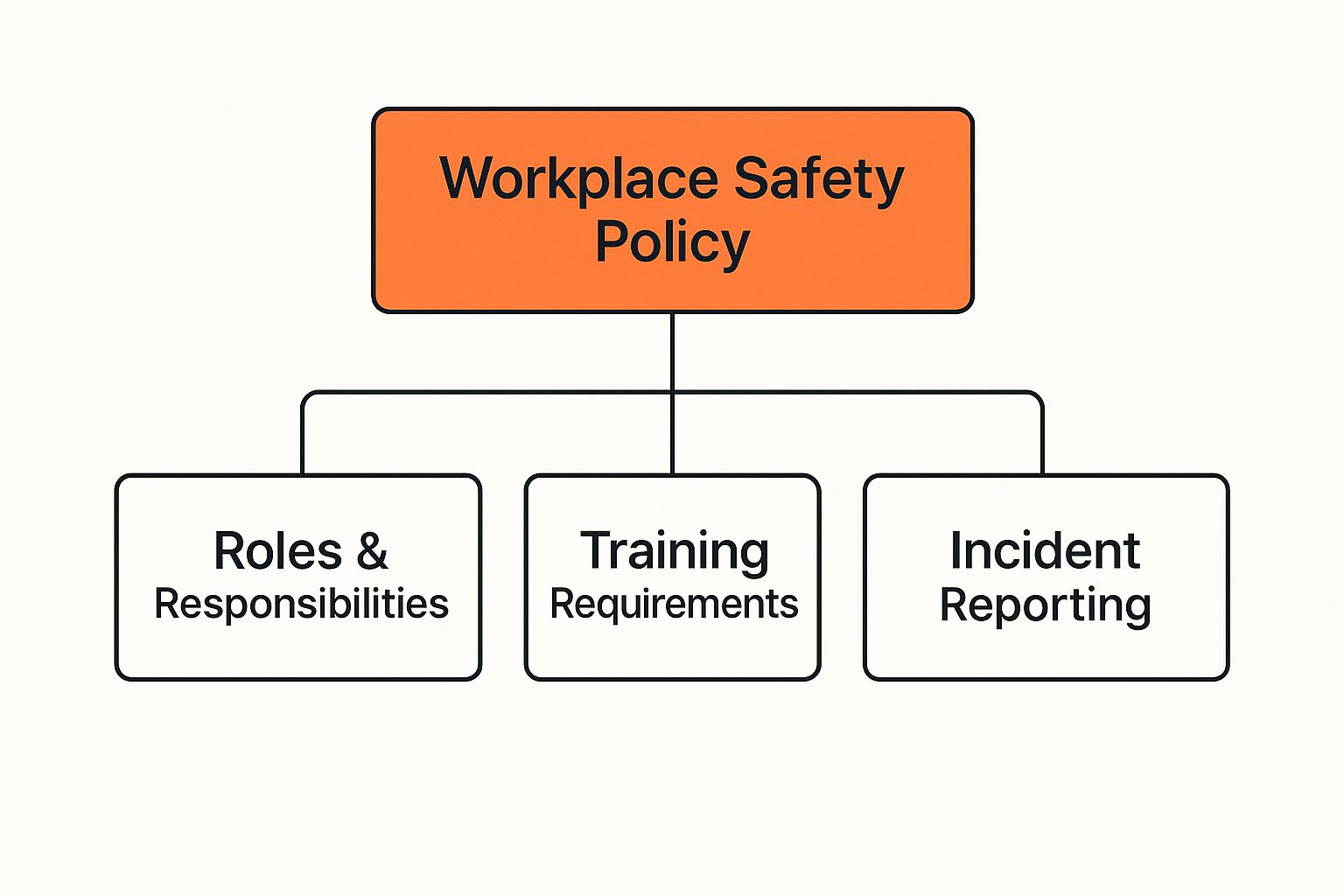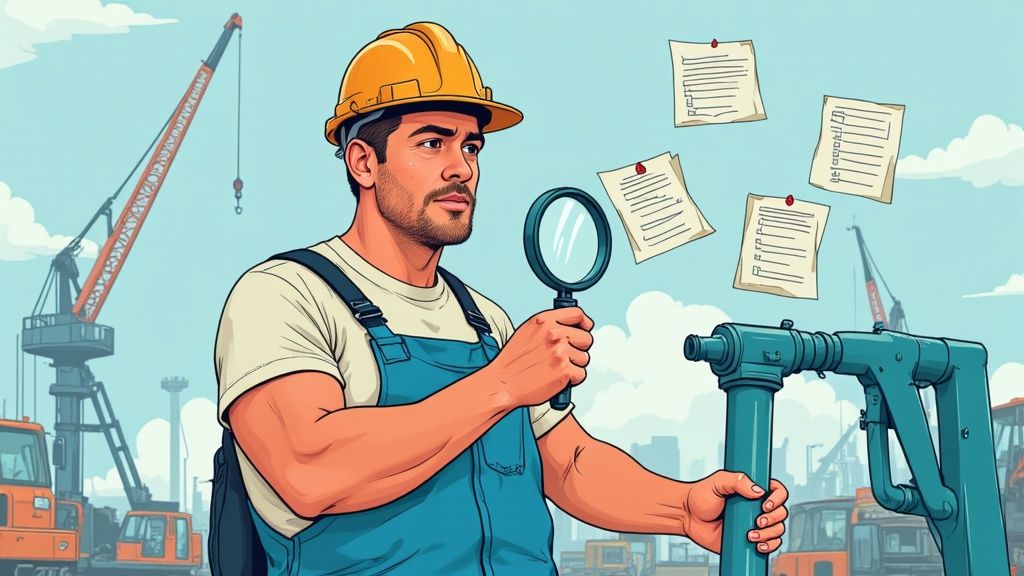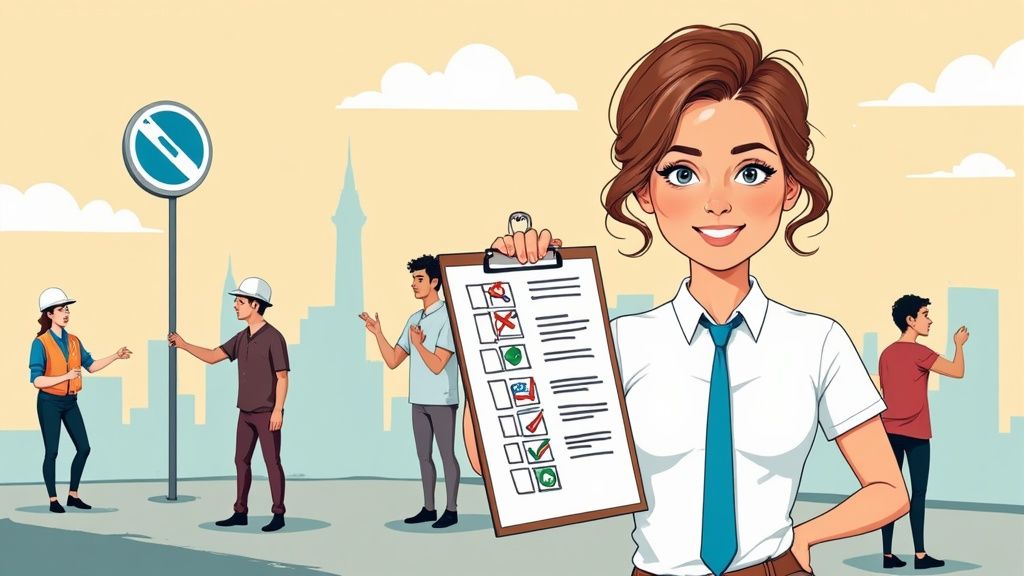A workplace safety and health policy is the official document that maps out your company's commitment to keeping people safe. It’s the blueprint that defines the rules, responsibilities, and procedures you’ll use to prevent injuries and illnesses on the job.
Think of it less as a rulebook and more as a practical, day-to-day guide for how work gets done.
What Is a Workplace Safety and Health Policy Anyway?

At its heart, a workplace safety and health policy is your organisation’s foundational plan for protecting your team. It’s a formal statement that takes safety from a vague idea and turns it into a set of clear, actionable commitments everyone must follow.
This document becomes the single source of truth for everything safety-related. It explains how you'll spot hazards, control risks, and handle incidents if they happen. This isn't just about ticking legal boxes; it's about creating a predictable, safe environment where every single person knows what’s expected of them.
The Real Purpose of a Safety Policy
The main job of a safety policy is to set clear expectations. It tells employees, supervisors, and managers exactly what they need to do to maintain a safe worksite. Without this documented guide, safety becomes a guessing game, and that’s a recipe for disaster in high-risk environments like manufacturing or construction.
A well-written policy provides a framework for consistent, on-the-spot decisions. For example, if a machine guard is found to be faulty, the policy should spell out the immediate steps required, like locking out the equipment and reporting the issue. There's no room for confusion.
A safety policy isn’t just for show. It’s a practical tool that guides the actions of every person on site, from the newest apprentice to the managing director. It sets the ground rules for how work gets done safely.
Why This Document Matters
A strong workplace safety and health policy is non-negotiable for a few very practical reasons. It directly boosts operational stability by cutting down on incidents that lead to costly downtime, project delays, and workers' compensation claims.
Most importantly, it shows a clear, genuine commitment to protecting your most valuable asset: your people.
It also serves as a crucial reference point for:
- Training and Induction: The policy is the bedrock for teaching new hires about your company's safety standards right from day one.
- Defining Responsibilities: It clearly assigns safety duties, so everyone understands their specific obligations and who is accountable for what.
- Incident Investigation: When something goes wrong, the policy provides a standard to measure actions against, helping to pinpoint root causes far more effectively.
Ultimately, this document is the core of any organised approach to occupational health and safety.
Getting to Grips with Your Legal Duties Under WHS Law
Okay, so we've talked about what a policy is in general terms. Now, let's get down to the brass tacks: the legal ground it stands on. In Australia, your safety obligations aren't just well-meaning suggestions; they're serious legal requirements under Work Health and Safety (WHS) laws.
These laws are built to be practical. They focus on what’s reasonably achievable to keep people safe from harm.
At the heart of it all is the term PCBU, which stands for a 'person conducting a business or undertaking'. It’s a deliberately broad term for a reason. It ropes in everyone from sole traders and partnerships to large companies, basically, anyone in charge of a work operation. If you’re a PCBU, the buck stops with you. You hold the primary legal responsibility for the health and safety of your workers and anyone else who might be affected by your work, like visitors or contractors.
This core responsibility is called the primary duty of care. It legally requires you to eliminate or minimise health and safety risks, so far as is reasonably practicable. This isn't about chasing some impossible, risk-free utopia. It’s about doing what is sensible and possible in your specific situation to stop people from getting hurt.
What Does ‘Reasonably Practicable’ Actually Mean?
"Reasonably practicable" is the phrase that underpins all WHS law, and it’s crucial to understand it. Think of it as a balancing act. You have to weigh up the likelihood and severity of a potential hazard against the real-world options you have to control it.
You need to consider a few things here:
- How likely is it that the hazard or risk will actually happen?
- If it does happen, how badly could someone get hurt?
- What do you already know, or what should you reasonably know, about the hazard and the ways to fix it?
- What are the available and suitable ways to get rid of the risk, or at least reduce it?
- And finally, what is the cost involved in using those control measures?
For example, let's say you've got a heavy machine on a factory floor that’s creating a dangerous level of noise. It’s absolutely 'reasonably practicable' to give your workers top-quality hearing protection. It would not, however, likely be considered reasonably practicable to replace the entire million-dollar machine if noise-dampening panels and personal protective equipment (PPE) can get the job done and effectively control the risk.
The consequences for getting this wrong are becoming more severe. As of April 2025, a sobering 32 workers had already been killed on the job in Australia this year. This tragic trend has spurred the government to introduce new laws that can hold employers criminally liable for reckless actions leading to a death, with potential jail time of up to 25 years. You can learn more about the push for stronger safety regulations and what it means for you.
Putting Your Legal Obligations into Practice
These legal duties aren't just abstract ideas found in a textbook. They translate directly into specific, everyday actions that need to be built into the way you operate. A solid workplace safety and health policy is your way of documenting and proving you are meeting these obligations.
Here are the non-negotiable duties your policy absolutely must cover:
- Provide a Safe Work Environment: This is the physical space itself. We’re talking clear walkways on a construction site, proper ventilation in a workshop, and ensuring structures are stable and secure.
- Maintain Safe Plant and Structures: You’re responsible for making sure all your machinery, equipment, and buildings are regularly inspected, properly maintained, and safe for people to use.
- Implement Safe Systems of Work: This means having clear, documented procedures for high-risk tasks. Think about things like operating a crane, working in a confined space, or handling hazardous chemicals.
- Ensure Safe Use of Substances: Your team needs crystal-clear instructions for how to handle, store, and transport any chemicals or other hazardous materials safely.
- Provide Information, Training, and Supervision: It’s your duty to ensure every worker is properly trained for their role and supervised, especially when they’re new or doing something they haven’t done before.
- Consult with Your Workers: This one is critical and often overlooked. You must talk to your workers about WHS matters that directly affect them. They’re on the frontline; they see the real risks every day and often have the best ideas on how to fix them.
Scenario in Action: A construction site manager spots a new subcontractor using frayed, damaged extension cords right near a wet area. Under their primary duty of care, the manager has to act immediately. They stop the work, pull the subcontractor aside to discuss the hazard, and make sure compliant, undamaged equipment is brought in before work can restart. This isn't just a "good idea", it's a legal requirement in action.
Core Components of a Strong Safety Policy
A strong workplace health and safety policy isn't just a document you write once and file away. It's a living framework built from a few non-negotiable parts that work together to create a clear, practical guide for protecting your team. If you miss a piece, the whole system can become confusing, incomplete, or impossible to actually use when it matters most.
Think of it like building a critical piece of machinery. Every bolt, gear, and wire has a specific job. Leave one out, and the entire thing might fail under pressure. Let's break down these essential components one by one.
The Foundation: Management Commitment
This is where it all starts. The commitment statement is a clear declaration from the very top of your organisation that safety is a core value, not just a compliance task. It's usually signed by the CEO or managing director, showing everyone that accountability begins at the highest level.
This isn't just corporate fluff; it sets the tone for everything that follows. A genuine, visible commitment from leadership is the engine that drives the entire safety program forward.
Defining Roles and Responsibilities
One of the quickest ways for a safety system to fail is confusion over who is supposed to do what. A solid WHS policy cuts through that ambiguity by clearly defining safety duties for every single person in the organisation. You have to get specific here.
It’s not enough to just say, "everyone is responsible for safety." You need to spell out the exact duties for different roles so nothing falls through the cracks.
For example:
- Site Manager: Responsible for ensuring risk assessments are completed for high-risk tasks, allocating budget for safety gear, and leading incident investigations.
- Machine Operator: Responsible for doing pre-start checks on their equipment, reporting faults or hazards immediately, and wearing all required personal protective equipment (PPE).
- All Workers: Responsible for following established safety procedures, reporting all injuries and near misses, and actively participating in safety training and meetings.
This clarity ensures everyone knows their part to play, stopping the classic "I thought someone else was handling it" problem before it starts.
The image below shows how these key components, like defining roles, training, and reporting, all connect to form the structure of a robust policy.

This visual really highlights how interconnected these elements are, showing how a well-organised policy covers all the critical safety functions.
Identifying Hazards and Controlling Risks
This is the technical heart of your policy. It's where you outline the systematic process your organisation uses to find workplace hazards, figure out how risky they are, and then put effective controls in place. A good policy will describe the methods you'll use, like regular site inspections, Job Safety Analyses (JSAs), and simply talking to your workers.
Crucially, it must commit to the hierarchy of controls, a step-by-step approach for managing risks. The policy has to state that the first priority is always to eliminate the hazard completely. If that’s not possible, you work down the list: substitute the hazard, use engineering controls, then administrative controls, and only as a last resort, rely on PPE.
Your WHS policy needs to make it crystal clear that PPE is the last line of defence, not the first solution. The real goal is always to get the hazard out of the workplace entirely.
Emergency Preparedness and Response
No matter how good your preventive measures are, you have to be ready for when things go wrong. This section details your procedures for handling emergencies, and it needs to be practical and easy to follow under pressure.
Key details to include are:
- Evacuation Procedures: Clear instructions on exit routes, assembly points, and who is in charge of headcounts.
- Medical Response: Steps to take for injuries, including where to find first aid kits and contact details for first aiders and emergency services.
- Specific Emergencies: Procedures for events relevant to your site, like chemical spills, fires, or structural collapses.
Having this part of the policy nailed down ensures a coordinated and effective response during a crisis, which can dramatically reduce the severity of an incident. To see how these pieces fit into a bigger picture, it's worth exploring the 9 key elements of a health and safety management system.
Incident Reporting and Investigation
Your policy must create a clear, blame-free process for reporting all workplace incidents, that includes injuries, illnesses, and especially near misses. The entire point is to learn from these events so they don't happen again.
This section should specify:
- Who to report to and how quickly.
- The process for investigating incidents to find the real root cause.
- A commitment to implementing corrective actions based on what the investigation finds.
Encouraging near-miss reporting is so important. A near miss is a free lesson on what could have gone wrong, and investigating it helps you fix a serious problem before it actually hurts someone.
Essential Components of a WHS Policy
To tie it all together, this table gives you a quick summary of the non-negotiable sections every workplace safety and health policy should have.
| Policy Component | Purpose | Example Action |
|---|---|---|
| Management Commitment | Establishes top-down authority and priority for safety. | CEO signs the policy and allocates resources for safety initiatives. |
| Roles & Responsibilities | Defines clear safety duties for all personnel levels. | Outlining a supervisor's duty to conduct weekly toolbox talks. |
| Hazard Management | Outlines the process for identifying and controlling risks. | Requiring a Job Safety Analysis (JSA) before starting non-routine tasks. |
| Emergency Procedures | Provides clear instructions for responding to crises. | Conducting and documenting a fire drill every six months. |
| Incident Reporting | Creates a system for learning from accidents and near misses. | A worker fills out a near-miss report after a tool falls from scaffolding. |
Getting these core components right means you're not just writing a document for compliance; you're building a practical tool that genuinely keeps your people safe.
How to Develop and Write Your Safety Policy
Creating a workplace safety and health policy isn't about ticking boxes or filling out a template you found online. It’s a hands-on process. You need to build a document that actually fits your worksite, something your team will read, understand, and use.
The goal is a clear, practical guide, not another generic document destined to gather dust on a shelf. So, let’s walk through the steps to develop a policy that makes a genuine difference on the ground.

Step 1: Assemble Your Team and Consult Workers
The first step isn't to start writing, it's to start talking. Any policy handed down from the top without input from the people doing the actual work is destined to fail. You need to pull together a small, dedicated team to get this process started.
This team should be a mix of people from across the organisation:
- A senior manager with the authority to sign off on the final policy.
- A supervisor or team leader who knows the daily operations inside and out.
- A frontline worker who sees the real-world risks every single day.
- A designated safety representative, if you have one.
The most critical job for this team is consultation. WHS law actually requires you to consult with your workers on things that affect their health and safety. Get out on the factory floor or the construction site and ask them straight: What are your biggest safety concerns? Where do the near misses happen? What would make your job safer? Their insights are pure gold because they’re based on direct experience.
Step 2: Conduct a Thorough Risk Assessment
Once your team is in place and you've gathered feedback from the crew, it's time for a formal risk assessment. This is basically a systematic search across your entire workplace for anything that could cause harm. You need to look at everything, from the machinery people use to the physical environment they work in.
Break it down into manageable chunks:
- Identify the Hazards: Walk through the site and make a list of everything with the potential to cause an injury. This could be anything from unguarded machinery in a workshop to trailing cables across a busy walkway.
- Assess the Risks: For each hazard, figure out how likely it is to cause harm and how bad that harm could be. A spill on the floor, for instance, is highly likely to happen and could easily cause a serious injury from a slip and fall.
- Identify Control Measures: Now, decide on the best ways to eliminate or reduce these risks. Don't forget the hierarchy of controls, always try to eliminate the hazard completely before anything else.
This assessment becomes the backbone of your policy. It ensures the rules you write are directly tied to the real dangers present in your specific workplace.
Step 3: Draft the Policy in Plain English
Okay, now it's time to start writing. But the golden rule here is to keep it simple. Your safety policy must be written in clear, direct language that absolutely everyone can understand. Ditch the legal jargon and complicated corporate speak.
Think of it like this: a new apprentice should be able to pick it up, read it, and know exactly what’s expected of them to stay safe.
Your policy is a communication tool first and a compliance document second. If your workers can’t understand it, they can’t follow it, making it useless.
Use short sentences, simple words, and bullet points to make the document easy to scan and digest. When you're drafting, use the core components we covered earlier as your structure. Kick off with the management commitment, then clearly lay out roles and responsibilities, hazard control procedures, and emergency plans. If you run a metal fabrication workshop, you’ll need specific procedures for using welders and angle grinders, not just a vague statement about "safe equipment use."
Step 4: Review and Finalise the Document
With a solid draft in hand, the final step is to get it reviewed and signed off. This isn't just a formality; it's another crucial chance for consultation and refinement.
Here’s who needs to lay eyes on the draft before it goes live:
- The Development Team: The group that wrote the policy should give it a final check to make sure nothing was missed.
- Workers and Safety Reps: Get the draft in front of the people it affects most. Ask them if it's practical and if it makes sense from their point of view.
- Senior Management: The final policy has to be officially reviewed and signed by a director or CEO. That signature is a powerful, visible declaration that the company stands behind every single word in that document.
Once you've incorporated any final feedback, the policy is good to go. The sign-off from the top formally puts the policy into effect and shows everyone that safety truly starts at the very top of the organisation.
Putting Your Safety Policy Into Action
A workplace safety and health policy is only as good as its execution. A beautifully written document gathering dust on a shelf or sitting forgotten in a server folder doesn’t prevent a single injury. The real work starts when that policy makes its way from the page to the factory floor.
It’s about turning those written commitments into the everyday, practical actions that actually protect your team. This means making sure every single employee not only gets a copy of the policy but truly understands what it means for them and their specific role.
Communication Is Not a One-Off Event
Handing over the policy during a new hire's induction is the absolute baseline. It sets the expectation from day one that safety is non-negotiable. But that’s just the beginning. Good communication is an ongoing conversation, not a single announcement.
To keep your policy alive and top-of-mind, you need to weave it into the fabric of your daily operations. Here’s how:
- Regular Toolbox Talks: These short, sharp meetings are perfect for discussing parts of the policy relevant to the day's work. Are the guys working at heights? Let's quickly review the fall protection procedures. Is a new chemical being introduced? Time for a refresh on the handling protocols.
- Visible Reminders: Plaster key info where people will actually see it. Emergency contact numbers, hazard reporting steps, and other critical points should be posted in high-traffic spots like break rooms, workshops, and site offices.
- Easy Digital Access: Make sure the full policy is just a few clicks away on the company intranet or portal. When a worker has a question, they should be able to find the answer instantly without having to hunt for it.
The goal is to make your safety policy a constant, familiar presence, not a document they see once and promptly forget.
Training on Specific Procedures
Your policy is full of critical procedures designed to control specific risks, and your team needs to be properly trained on how to follow them. It’s not enough to just tell a machine operator to "work safely." You have to show them, step-by-step, how to perform a lockout/tagout before they even think about doing maintenance.
Effective workplace safety training has to be practical and hands-on. It’s the bridge that connects the rules in the policy document to the real-world actions on the job, turning abstract statements into ingrained, safe work habits.
A massive part of putting your policy into practice is creating clear Standard Operating Procedures (SOPs). These are the nitty-gritty, step-by-step instructions that bring your high-level policy commitments down to ground level for your team.
Monitoring and Enforcing the Policy
Once you’ve communicated the policy and trained your people, how do you know if it’s actually working? You need to actively check that the procedures you've put in place are being followed. Consistently.
This boils down to two key activities:
- Regular Site Inspections: These are proactive walks through the worksite with one goal: to see your policy in action. Are machine guards where they should be? Is everyone wearing their PPE correctly? Are walkways clear of trip hazards? These checks help you spot small deviations before they snowball into a serious incident.
- Incident and Near-Miss Reviews: When something goes wrong, or almost goes wrong, your policy's investigation procedure needs to kick in immediately. Reviewing incidents and, just as importantly, near misses gives you priceless feedback on where your policy might have gaps or where your procedures simply aren't being followed.
Let's be clear: this isn't about playing "gotcha" and catching people out. It’s about confirming the system is working and identifying where you might need to offer more training, better resources, or clearer instructions.
Addressing Emerging Workplace Risks
A static policy is a weak policy. Your worksite isn't static, and neither are the risks. A great safety policy is a living document, flexible enough to tackle new and growing threats.
A perfect example of this in Australia is the alarming rise in customer aggression. Recent data shows that nearly two-thirds of workers have experienced aggression from customers. The same report found that 35% of them received zero support from their employer afterwards, highlighting a massive gap in how this risk is being managed.
Your policy must give workers clear, practical steps to follow when they’re facing these situations. This should include procedures for de-escalation, instructions on how to report aggressive incidents, and clear pathways to access support services after an event.
By actively communicating, training, monitoring, and adapting, you transform your safety policy from a static piece of paper into a dynamic, living system that actively protects your people, day in and day out.
When and How to Review Your Safety Policy

A workplace safety and health policy should never gather dust on a shelf. It’s a living document that needs to keep pace with your worksite. People change, equipment gets updated, and projects evolve. If your policy stays static, it quickly becomes irrelevant and ineffective.
Think of it like the routine maintenance you’d perform on a critical piece of machinery. You wouldn't let an excavator run for years without a proper check-up, and the same logic applies to your safety framework. Regular reviews aren’t just a box-ticking exercise; they're essential for keeping your team safe from real, ever-changing risks.
Triggers for an Immediate Policy Review
While an annual review is a good baseline, some events are too important to ignore. Waiting for a scheduled check-in could leave your team exposed to uncontrolled hazards. Certain situations should trigger an immediate and thorough update.
Here are the big ones:
- After a serious incident or a near miss: This is your most critical learning opportunity. The policy must be updated to make sure it never happens again.
- Introducing new equipment or processes: A new crane, a different chemical, a new way of working, they all bring new risks that your old policy won't cover.
- Changes in key personnel: If the people listed as primary safety contacts or responsible managers leave the business, the policy needs an immediate fix.
- Updates to WHS legislation: Laws and codes of practice change. Your policy has to reflect the current legal requirements to keep you compliant.
This isn't just theory. Recent data shows that fatalities from falls from heights increased by a staggering 71% between 2022 and 2023. In 2023 alone, 200 workers were fatally injured on the job, a clear increase from the previous year. You can read the full report about these workplace safety trends to see exactly why your policy needs to adapt to rising risks.
A policy review isn't about finding fault. It’s a proactive step to confirm your safety procedures still match the reality of your worksite and address the most pressing dangers your team faces.
Got Questions About Your Safety Policy?
Even with a clear roadmap, a few common questions always pop up when you're in the thick of creating or managing a workplace safety policy. Let's get them answered.
Who Is Legally on the Hook for the Policy?
The buck stops with the Person Conducting a Business or Undertaking (PCBU). That’s the official term, but in real life, it means the company owner, director, or the most senior leader is ultimately accountable. They're the ones legally responsible for making sure a policy is created, put into action, and kept alive.
Your safety manager might be the one typing it up, but the legal responsibility sits right at the top. This is exactly why getting that signed commitment from leadership isn't just a formality, it's their formal nod to this critical duty.
Can We Just Download a Template and Be Done with It?
Using a template is a brilliant way to get started, but it's just that, a start. You absolutely cannot just copy and paste it and call it a day. A template gives you a solid frame, but the policy itself has to be built around the real-world hazards and daily grind of your specific worksite.
Think about it: a safety policy for a busy manufacturing plant will be miles away from one for a construction crew out in the field. You have to do your own risk assessment and shape the policy so it actually makes sense and works for your team.
A generic policy that doesn't mirror your day-to-day risks is just a piece of paper. It gives a false sense of security and, more importantly, fails to meet your legal duty of care. Making it your own isn't just a good idea; it's essential.
How Often Do We Need to Train People on This?
Training is definitely not a one-and-done deal. At the bare minimum, every single worker needs to be trained on the policy when they first walk through the door as part of their induction.
After that, you'll need to run refresher training:
- Annually, as a good rule of thumb.
- Any time you make significant changes to the policy.
- If you bring in new high-risk gear or change a major process.
- After an incident or a string of near misses that shows people aren't quite getting it.
Regular toolbox talks are also a fantastic, informal way to keep specific parts of the policy fresh in everyone's mind, especially as it relates to the work they're doing that day.
A solid workplace safety and health policy is the bedrock of a safe workplace. At Safety Space, we've built an all-in-one digital platform to help you build, implement, and manage your entire safety system without the usual headaches. Book a free demo to see how Safety Space can simplify your safety compliance.
Ready to Transform Your Safety Management?
Discover how Safety Space can help you build a safer, more compliant workplace with our comprehensive safety management platform.
Book a Free DemoRelated Topics
Safety Space Features
Explore all the AI-powered features that make Safety Space the complete workplace safety solution.
Articles & Resources
Explore our complete collection of workplace safety articles, tools, and resources.
